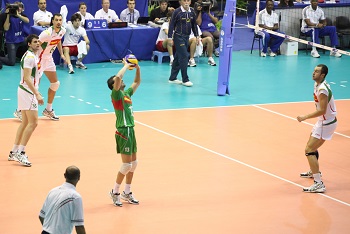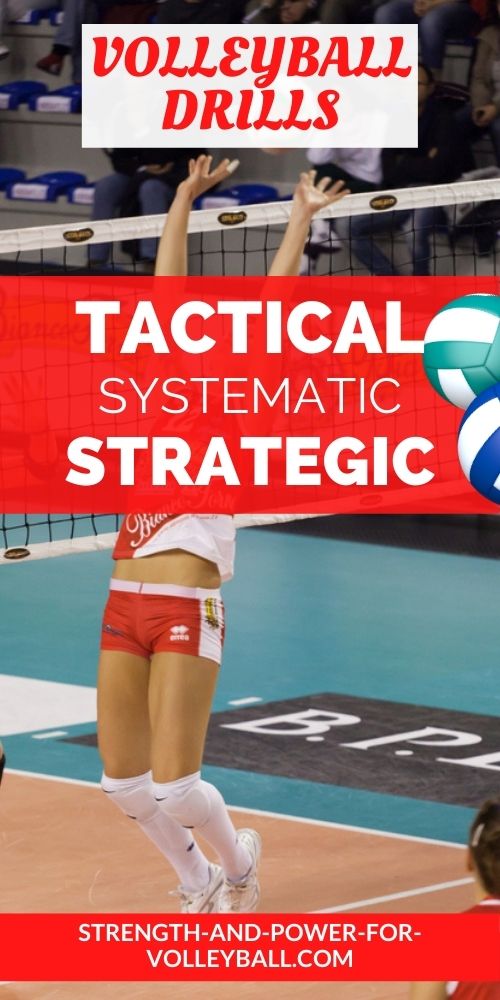Volleyball Drills
Conditioning and Skills with Tactics
Volleyball drills are used to enhance various performance factors such as ball control, footwork, and timing on approach jumps or blocks.
Coaches and players need to understand the importance of training with purpose.
A purpose of a drill could be to fix a problem, or improve volleyball skills such as passing or hitting.
Performing your drills with purpose has many benefits...
- If a player understands the purpose of the drill, rather than just going through the motions, they will be more interested in the training.
- Drills for volleyball are important for developing habits. If players are constantly focusing on how to perform a volleyball drill correctly, they will improve their ability to focus during competition.
- If coaches will set goals and set a specific focus to a drill, they will have better understanding of when to move on or adjust the drill for a better training effect.
Volleyball drills can be broken down into 3 categories ...
- Skill and Movement Specific
- Tactical, Systematic, Strategic
- Volleyball Conditioning Specific
Skill and Movement Specific
Volleyball skill and movement drills are the most common types of drills coaches have their players perform.
Skill and movement drills are designed to help players enhance their volleyball skills through repetition.
It's important to note that the purpose of these drills is to develop playing skills such as blocking and setting. These aren't volleyball conditioning drills.
Furthermore, it's important for every player to understand the specific goals of each drill and what skills need to be of focus.
Use repetition to build habits Drills help you develop skills through repetition and practicing with purpose.
Drills for beginning players should focus on executing the drill with proper technique.
It's important to realize that every second you spend on the court, whether in practice, competition, or just playing a pick up game, you are continually creating or building upon habits.
It's much wiser to develop correct skills early, when you first start playing the game because it's much more difficult to change technique wants habits have been made.
If you enjoyed these tips and would like to keep it close to you at any time, just save this pin to your Pinterest Volleyball Training Board.
Volleyball drills should be progressive
Players need to perform drills progressively, depending on their playing experience and the time of year of training.
Drills range from learning an individual skill such as a forearm pass, to learning combinations of skills such as blocker pulling off the net and then taking an approach to hit.
The difficulty of drills need to progress appropriately with the players in training.
For example, let's say you are performing a drill that involves making a pass then taking an approach to hit. If the focus of the drill is to execute an effective attack hit, and your passing skills are lacking, the focus of the drill will become making better passes.
This drill turns into a passing drill, when the intent was to work on hitting.
Therefore, it is important volleyball drills are modified to fit the ability of the individual players.
Performing these drills with proper focus, repetition, and progression saves time and energy.
Tactical, Systematic, Strategic
Tactical, systematic, and strategic drills focus on team execution.
These drills often involve combinations of playing skills.
Therefore, these drills are often most effective when performed after players have developed their individual playing skills.
Volleyball coaches often have very different philosophies when it comes to playing strategy. Player's have different talents, strengths, and weaknesses that make their teams unique.
For these reasons, strategic drills often vary from one team to another.
It is often wise to run teams through fun drills that are unique and different from what players are used to. Fun volleyball drills will often spark creativity in players and help avoid volleyball player burnout.
Team communication is important Every team needs team drills that help train their players to interact with one another.
Drills that involve players calling the ball to pass or communicating to attackers where to hit are important to success.
Volleyball Conditioning Specific
Volleyball drills can often be designed with the focus being on volleyball conditioning.
If conditioning is one of the goals of a volleyball drill, coaches need to be aware the energy needed may take away from performing the drill with proper skill technique.
Volleyball drills can often be designed with the focus being on volleyball conditioning.
If conditioning is one of the goals of a volleyball drill, coaches need to be aware the energy needed may take away from performing the drill with proper skill technique.
It is most common to perform conditioning drills in the off-season and pre-season rather than in-season because proper skills execution is less important during these times.
It's usually best to train volleyball skills and conditioning separately when in-season.
For example, when in-season a team could work on sharpening their passing skills at practice when they are fresh. They may have a separate time during practice or maybe a separate day for conditioning.
Obviously, the volleyball team that has gone through the proper volleyball conditioning in the off-season and pre-season is going to have a much bigger advantage over the teams that haven't.
While the teams that are "out of shape" when the season starts are trying to build up their conditioning, the teams that are in good volleyball condition will just need to work to maintain their high level of conditioning which allows for a much easier time sharpening their skills and working on team tactics and strategies.
Volleyball Drills Related Pages
Spiking Drill for Mastering Spike Mechanics
Arm swing tips for spiking a volleyball. Learn how to hit a volleyball correctly and generating spiking power to hit harder. Volleyball approach and spike tips.
Serve Receive Drill
Serve receive drill that teaches anticipation and forces servers to take chances. This is one of my favorite serve receive drills because it's fun, competitive, and makes passers anticipate the serve...
Volleyball Practice Drills
Volleyball practice drills sometimes need to be adjusted to make players more motivated and inspired. Make your volleyball team focus more by...
Fun Drills
Every volleyball team needs fun drills to spark player enthusiasm and excitement. A fun volleyball drill can liven up player creativity...
Easy Volleyball Drills
Easy volleyball drills for beginning level players. When first starting out playing youth volleyball, there are some basic skills that need to be mastered. Developing these skills will save a ton of time and...
Beginner Drills
Volleyball Beginner Drills are good not only for players that are new to volleyball, but also players...
Team Drills
Volleyball Team drills are important for learning communication skills and also for learning how to play together.
Hitting Drills
Volleyball players need volleyball drills for learning how to spike a volleyball. Technique for the volleyball spike approach...
Volleyball Blocking Drills
Learning to block is especially valuable if your team doesn't play very good defense. Volleyball blocking drills...
Volleyball Setting Drills
Volleyball setting drills usually involve setting balls from a coaches toss or from players passes.
Volleyball Passing Drills
Volleyball passing drills help players learn to move their feet and get in good position to...
Volleyball Conditioning Drills
Volleyball conditioning drills should be included in team practices. To develop a high level of conditioning, volleyball drills can...
Volleyball Footwork Drills
Volleyball footwork drills for hitting and setting. Techniques for approaching to spike and getting in position to set. Proper footwork patterns are critical for success...
Learning to Hit a Slide
Tips and techniques for spiking. Tips for approaching and hitting slides. Also, drills and tips for blocking a slide.
Ball Control Drills
Volleyball ball control drills for improving anticipation, communication and ball control. Improve player skills through cooperative team chaotic play...
45 Drills for Passing a Volleyball
Passing volleyball drills for quickly learning how to pass a volleyball. Take your volleyball passing skills to the next level with these volleyball passing drills.
30 Partner Drills
Volleyball drills with a partner. Up your volleyball game with partner drills! Push yourself to the next level with these challenging drills to keep you
Serving Drills
Volleyball serving drills. By learning the right volleyball serving strategies and drills, you can become a much more effective server.
Drills Without a Net
Volleyball drills without net. How to train for volleyball on your own without a net. Best at home volleyball drills.
7 Setting Drills to Master
Volleyball setter drills will help you become a great volleyball setter. Master hand setting technique and volleyball footwork for setting.
Volleyball › Volleyball Drills
- Home
- Drills

